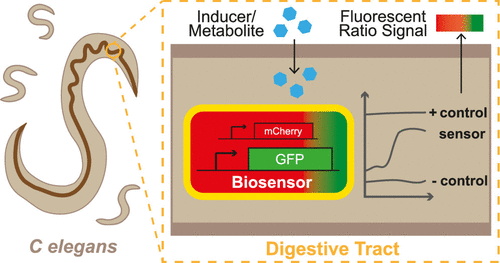当前位置:
X-MOL 学术
›
ACS Synth. Biol.
›
论文详情
Our official English website, www.x-mol.net, welcomes your
feedback! (Note: you will need to create a separate account there.)
Detecting Changes in the Caenorhabditis elegans Intestinal Environment Using an Engineered Bacterial Biosensor.
ACS Synthetic Biology ( IF 3.7 ) Pub Date : 2019-11-08 , DOI: 10.1021/acssynbio.9b00166 Jack W Rutter 1 , Tanel Ozdemir 1 , Evgeniy R Galimov 2 , Leonor M Quintaneiro 3 , Luca Rosa 1 , Geraint M Thomas 1 , Filipe Cabreiro 2, 3 , Chris P Barnes 1, 4
ACS Synthetic Biology ( IF 3.7 ) Pub Date : 2019-11-08 , DOI: 10.1021/acssynbio.9b00166 Jack W Rutter 1 , Tanel Ozdemir 1 , Evgeniy R Galimov 2 , Leonor M Quintaneiro 3 , Luca Rosa 1 , Geraint M Thomas 1 , Filipe Cabreiro 2, 3 , Chris P Barnes 1, 4
Affiliation

|
Caenorhabditis elegans has become a key model organism within biology. In particular, the transparent gut, rapid growing time, and ability to create a defined gut microbiota make it an ideal candidate organism for understanding and engineering the host microbiota. Here we present the development of an experimental model that can be used to characterize whole-cell bacterial biosensors in vivo. A dual-plasmid sensor system responding to isopropyl β-d-1-thiogalactopyranoside was developed and fully characterized in vitro. Subsequently, we show that the sensor was capable of detecting and reporting on changes in the intestinal environment of C. elegans after introducing an exogenous inducer into the environment. The protocols presented here may be used to aid the rational design of engineered bacterial circuits, primarily for diagnostic applications. In addition, the model system may serve to reduce the use of current animal models and aid in the exploration of complex questions within general nematode and host-microbe biology.
中文翻译:

使用工程细菌生物传感器检测秀丽隐杆线虫肠道环境的变化。
秀丽隐杆线虫已成为生物学中的关键模型生物。特别是,透明的肠道、快速的生长时间以及创建明确的肠道微生物群的能力使其成为理解和改造宿主微生物群的理想候选生物。在这里,我们介绍了一种实验模型的开发,该模型可用于表征体内全细胞细菌生物传感器。开发了响应异丙基 β-d-1-硫代半乳糖苷的双质粒传感器系统,并在体外进行了充分表征。随后,我们表明,在将外源诱导剂引入环境中后,该传感器能够检测并报告秀丽隐杆线虫肠道环境的变化。这里提出的协议可用于帮助工程细菌回路的合理设计,主要用于诊断应用。此外,该模型系统可以减少当前动物模型的使用,并有助于探索一般线虫和宿主微生物生物学中的复杂问题。
更新日期:2019-11-08
中文翻译:

使用工程细菌生物传感器检测秀丽隐杆线虫肠道环境的变化。
秀丽隐杆线虫已成为生物学中的关键模型生物。特别是,透明的肠道、快速的生长时间以及创建明确的肠道微生物群的能力使其成为理解和改造宿主微生物群的理想候选生物。在这里,我们介绍了一种实验模型的开发,该模型可用于表征体内全细胞细菌生物传感器。开发了响应异丙基 β-d-1-硫代半乳糖苷的双质粒传感器系统,并在体外进行了充分表征。随后,我们表明,在将外源诱导剂引入环境中后,该传感器能够检测并报告秀丽隐杆线虫肠道环境的变化。这里提出的协议可用于帮助工程细菌回路的合理设计,主要用于诊断应用。此外,该模型系统可以减少当前动物模型的使用,并有助于探索一般线虫和宿主微生物生物学中的复杂问题。











































 京公网安备 11010802027423号
京公网安备 11010802027423号